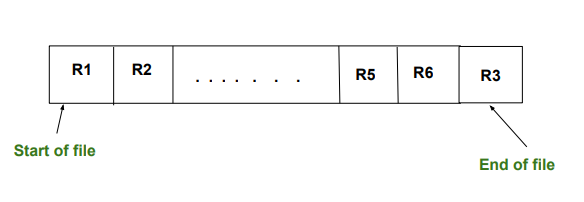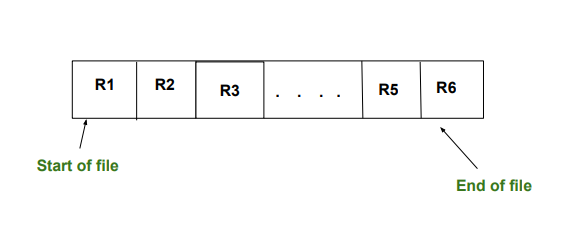
|
|
Sequential File Organization is a basic technique employed in a database management system DBMS for storing and retrieving data. It is mostly applied when data access is sequential or in a particular order. In this article, we will describe what sequential file organization is, define some fundamental terms about the method, depict a diagram of the sequential file organization, and give an insight into the process of accessing data sequentially in the method. Key Terminologies
Sequential File Organization and Access in DBMSSequential File OrganizationSequential File Organization is another way of filing records where records are arranged one after another in a sequence by putting them in the order of the particular field or key. Programs that involve record series, such as batch processing or report generation, could be optimized in this structure. There are two main types of sequential file organization: Pile File Method and Sorted File Method. 1. Pile File MethodThe Pile File Method is the simplest form of sequential file organization. ;No particular order is followed; records are saved in the order they are received. The more records there are, the less effective this strategy can be, despite its simplicity and ease of implementation. Characteristics of Pile file method
When inserting a new record in the Pile file method the new record gets directly added to the end of the file whether it is in sorted order or not.  Inserting a new record in a file. The appended record R3 will now be available at the end of file:  The inserted record R3 at the end. 2. Sorted File MethodThe Sorted File Method ensures that the entries are sorted by arranging them in file with reference to a key field. This method enhances search flexibility and fast accessing of data since records can be searched faster in a sorted way. But to place things in this manner, may not be easy especially when inserting or deleting certain records. Characteristics of Sorted file method:
When a new record is inserted as shown in the figure below:  Inserting a new record in Sorted file method. The new record gets inserted at a position such that the all the records should continue maintaining their sorted manner as shown below:  Inserted record R3 in sorted file method. Sequential Access in DBMSReading or writing records in the order that they are stored is known as sequential access. The general sequential access procedure is explained in the subsequent steps:
Example : Consider a database table called Inventory that contains the “product_id”, “product_name”, and “quantity_in_stock” data. You must create an inventory report that includes a list of every product and its quantity. Steps for Sequential Access
Advantages
Disadvantages
ConclusionSequential File Organization is a clear and efficient means of putting data into a sequence file because it allows the data to be stored and retrieved in a specified manner. Thus, it can be from time to time convenient in cases where the sequential access of data is required; however, it is not a choice that end-users should make for applications that are going to write or read data at random. This knowledge will enable the identification of the right file organization technique for particular database applications by understanding how the technique of sequential file organization operates and the parameters that define this kind of technique. Sequential File Organization and Access in DBMS – FAQsCan we apply sequential file Organization to large datasets?
How does sequential access make use of the file pointer?
Can Sequential file Organization be used for streaming data processing?
|
Reffered: https://www.geeksforgeeks.org
| DBMS |
| Related |
|---|
| |
| |
| |
| |
| |
Type: | Geek |
Category: | Coding |
Sub Category: | Tutorial |
Uploaded by: | Admin |
Views: | 12 |